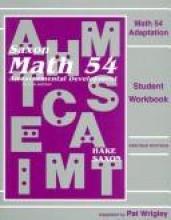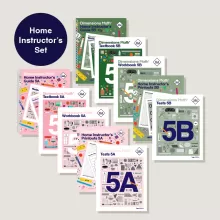Math Elementary - Text
Saxon Math
I have friends who have used Saxon for years and are very, very happy with it. Saxon's circular pattern and constant review is exactly what they love about it. However, it was this circular pattern that caused problems for us. The way Saxon works (someone please correct me if I'm off base here) is that it introduces a new concept in increments, the child works a set of problems that teach a new concept, then spends the rest of the lesson reviewing previously learned concepts. The next day, another new concept may be introduced with a few problems and then review of previous concepts including a problem or two from yesterday. Then further on in the book the first concept learned will be expanded upon and the review continues from there.
The reason Saxon didn't work for us was that it didn't spend enough time on a concept for her to fully grasp it and once she had mastered a concept the constant daily review irritated her. So, we had many days with either a totally frustrated child that thought she was dumb because she "didn't get it" or grumpy because she already knew how to do it and didn't see the value of doing it again and again. As you can see it could very well be a personality thing. We discovered that Torie learns better in "chunks", i.e.. learn a concept, work on it until it is mastered, then move on.
All the basic problem solving material and techniques are there - this is the whole rationale for the series. What it lacks is the founding principle that math is knowledge which is worthy of possessing for its own sake. Thus, it will fall short in depth. Practically speaking, it WILL prepare them for standardized tests - best at the lower grades. (Michael Van Hecke - headmaster of St. Augustine Academy in Ventura, California, and homeschool father)
Saxon Math 2
Saxon 2 covers the arithmetic topics of addition and subtraction of one and two digit numbers and simple multiplication and division as well as the related topics of patterns, graphing, time, measurement, money, geometry and estimating. Although it uses manipulatives it is not a "manipulatives-based" program.
Each day's lesson begins with oral exercises called "The Meeting" during which use of a calendar, counting, time, money, and patterns are practiced. The actual lessons follow and are completely scripted in the teachers edition. They are designed for four days of new material and one day of review. Math facts are practiced every day as well, using flash cards provided with the kit and fact sheet drills in the workbook.
The beauty of Saxon is repetition. Concepts are introduced and then reinforced over and over again. In Saxon 2 there are games, art projects and physical activites as part of the lessons which provide a break from strict pencil and paper work. My children had been doing a strictly manipulative based math program previously so I thought they wouldn't like Saxon, but they love it. I believe it is because of the variety of activities.
One drawback to Saxon is the price which is close to $100.00 for the homestudy kit. The kit includes a teacher's manual, workbook, meeting book and cardboard manipulatives and flash cards. It can be found in discount catalogs or used from fellow homeschoolers. It requires a set of manipulatives which can be purchased separately at teacher supply stores or as a kit from the source given by Saxon and various homeschool catalogs.
Singapore Math
Singapore students are scoring the highest in the world in math and science. The web page for these texts in the US is http://www.singaporemath.com
Singapore Math seems to solve the "conceptual/drill...Saxon jumping around problem". Here's an example from a problem in the first half of the fifth grade book:
<< Mr Li paid $36 for 3 singlets and 2 T-shirts. A T-shirt cost 3 times as much as a singlet. How much did Mr Li pay for the 2 T-shirts? >>
Apparently the children are taught to "think mathematically" and are able to solve these types of problems in 5th grade without using algebra....these types of problems lead up to a better understanding of algebra.
Multiplication Asian style The children learn facts families in sets ....for example they chant as follows
2 2 4 2 3 6 2 4 8 2 5 10
They don't say "times" or "equal" although that is explained to them. They are taught the reciprical nature of multiplication and division after they can chant this from memory they write out the sets as-
2x2=4 2x3=6 and so on 4/2=2 3x2=6...... 6/2=3 6/3=2
and finally provide answers for equations....then they go on to memorize the next set which would be
2 6 12 2 7 14 2 8 16 2 9 18
If anyone is thinking about going with this program I would suggest making the move before going in to New Elementary Math. It would be easier to acclimate to this way of thinking while still in Primary Math I believe.
There are answers at the back the book but no other aid. To be honest I think I would have trouble teaching this material. I did "ok" in math but not great and I don't remember more then basic algebra. If you tend to think mathematically and enjoyed algebra, trig. you could probably use this without too much effort.
The Singapore texts actually do have almost as much drill as other books I've used (Miquon, Horizon) but not as much as Abeka. For example in 3rd A Singapore gives about 8-10 examples of adding 5 digit numbers then the workbook has at least that many that the child does on their own. The difference is that Horizon has the child doing a few of those problems every day for a week or two while at the same time they introduce new things. Singapore moves on after 2 lessons that cover that...but the child should have mastered that skill before they can move on to the next lesson. In Asia the kids spend a lot of time working on drills at home.
In Saxon you learn to add fractions then you repeat the same level of adding fractions for 6 or 8 lessons in the doing 3 or 4 problems in each practice section. During the intervening lessons you jump from learning short division to dividing with remainders to using metric scale etc before you finally get back to fractions again.
With Singapore you learn to add fractions and spend maybe 3 lessons learning how to do that (slight difficulty increase with each lesson) then you move on to using the skill of adding fractions with word problems (real life) for a few lessons. By this time the child has probably done more fraction addition problems overall then they would do in Saxon. The skill is learned and won't be touched again until the review chapters. If the child has trouble, the teacher/parent shouldn't move on. I did this a few times with my son and regret it. The review chapters occur often enough that the child shouldn't forget.



